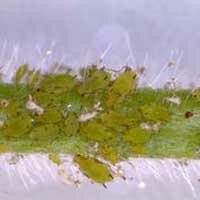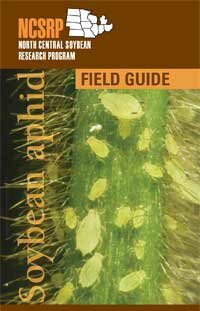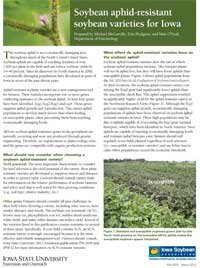
-
Soybean Diseases
- Asian Rust
- Anthracnose
- Bacterial Blight
- Bacterial Pustule
- Bean Pod Mottle Virus
- Brown Stem Rot
- Cercospora Leaf Blight
- Charcoal Rot
- Downy Mildew
- Frogeye Leaf Spot
- Green Stem Syndrome
- Iron Deficiency Chlorosis
- Phytophthora Root & Stem Rot
- Powdery Mildew
- Rhizoctonia
- Seedling Diseases
- Septoria (Brown Spot)
- SCN (Soybean Cyst Nematode)
- Soybean Mosaic Virus
- Stem Canker
- Sudden Death Syndrome
- Viruses
- White Mold
- Soybean Pests
- Diagnostic Help
- Field Trials
- Soybean Library
| Pest: Aphids |
| Soybean aphid biological control |
| Links |
Your Soybean Checkoff.
Delivering Results.
Illinois
Indiana
Iowa
Kansas
Michigan
Minnesota
Missouri
Nebraska
North Dakota
Ohio
South Dakota
Wisconsin
Soybean Aphid
 |
| Soybean aphid colony Photo credit: Thelma Heidel-Baker |

|
|
NCSRP Soybean Aphid Field Guide. |

|
| See Soybean aphid-resistant soybean varieties for Iowa 2013. (pdf) |
The soybean aphid (Aphis glycines) is the only aphid in North America able to develop large colonies on soybeans. It was first identified as a pest in North America in 2000. Since then, it has established itself as the most significant soybean pest in the north-central region.
Agronomic impact
When these tiny, sap-sucking insects are present in large numbers (several hundred per plant), their feeding can impact plant growth and cause stunting, leaf yellowing, reduced pod set, and reduced seed size and quality.
The risk of yield loss is greatest when aphid populations peak during the R1-to-R4 growth stages. During these stages, blooms and young pods are most suseptible to stress.
Damage from aphid feeding also increases when growing conditions are less than optimum.
Present and future tools to manage soybean aphids
Management of the soybean aphid is an active area of research in the north- central region. Growers now have an extensive toolbox of strategies to work with, including
- Well-established scouting procedures and an action threshold of 250 aphids/plant.
-
Host plant-resistant varieties - host plant resistance is a new and complementary tool to manage soybean aphid. Aphid-resistant varieties have the potential to simultaneously reduce insecticide use
and associated production costs, and also preserve natural enemies in soybean.
Host plant resistant genes for soybean aphid are prefixed with “Rag,” which is an abbreviation for “Resistant Aphis glycines.” These soybeans use two forms of resistance - antibiosis and antixenosis to reduce damage from soybean aphid feeding. Rag1 and Rag2 seed are commercially available in limited quality and for select maturity groups.
- Biological control - the soybean aphid would be a far more damaging pest were it not for natural enemies which provide biological control. Be aware of natural enemies such as lady beetle that keep aphids in check. A major regional research program is in progress with the goal of augmenting resident populations with specialist natural enemies.
- Insecticides - many effective foliar insecticide products are available for soybean aphid control. Another current option for aphid management is seed treatments using neonicotinoid insecticides.
- IPM - integrating aphid host resistance with biological control, scouting, insecticides, and crop management practices is the most effective strategy for aphid management.
